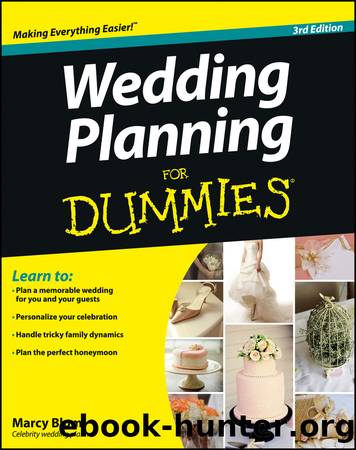Wedding Planning For Dummies by Marcy Blum

Author:Marcy Blum
Language: eng
Format: epub
Publisher: Wiley
Published: 2012-11-02T00:00:00+00:00
Chapter 12
Music to Get Married By
In This Chapter
Setting your ceremonyâs musical tone
Looking over some sample musical menus
Selecting musicians who hit the right notes
The music at a wedding sets the tone for the entire ceremony. The pieces you choose and the way theyâre played are decisions that you should consider carefully in tandem with the other elements of your ceremony. In this chapter, I provide suggestions for various types of ceremonies and guidelines for creating your own musical menu.
Theyâre Playing Our Song
Dozens of classical music pieces, although beautiful, are used so often in wedding ceremonies that theyâve lost the ability to inspire. That doesnât necessarily mean that you should be afraid to use such standards. The key is to find musicians who know how to make the music sound as if the pieces are perfect for your wedding. Or, if youâre using recorded music, choose exemplary versions of the classics or new pieces that are fun and impactful.
If those commonly used pieces arenât your cup of tea, begin your search by listening to CDs or MP3 files of classical wedding music collections (you can preview these on iTunes or Amazon.com before purchase â just enter âwedding musicâ into the search box). If you donât have any luck with that, expand your musical horizons and listen to other classical selections. Consider, for example, such baroque composers as Handel, Marcello, and Quantz.
Before you get your heart set on a particular piece of music, check to see whether a solo organist can play it or whether it works for the number of musicians in the group youâve contracted. Some of the musical pieces that you consider may only work for entire orchestras or may call for specific instruments that arenât in your ensemble.
Generally, I recommend getting a list of approved or suggested musical selections if youâre marrying in a religious venue. Donât assume that your selections, even if theyâre standard, will coincide with the churchâs guidelines. For many Christians, having the âBridal Chorusâ (commonly known as âHere Comes the Brideâ) from Richard Wagnerâs opera Lohengrin as the processional and Felix Mendelssohnâs âWedding Marchâ from A Midsummer Nightâs Dream as the recessional are as integral to their ceremony as the vows. Conversely, many churches donât allow those pieces, as theyâre secular rather than religious. Most synagogues donât allow those selections either, because Mendelssohn converted to Christianity and Wagner was a notorious anti-Semite.
Music in five parts
In general, a wedding ceremony has five facets of music:
Prelude: Played for 15 minutes to a half hour before the ceremony, this music welcomes the guests and plays in the background while theyâre seated. Keep that in mind when you make your selections â whether you prefer a festive, elegant, or religious spirit.
The prelude music, if you have no restrictions, can comprise any number of untraditional possibilities â an a cappella trio, an operatic soloist, or a quartet that specializes in classical renditions of Beatles songs. Some couples, tired of the usual variety of classical wedding music, opt for recorded music.
Download
This site does not store any files on its server. We only index and link to content provided by other sites. Please contact the content providers to delete copyright contents if any and email us, we'll remove relevant links or contents immediately.
The Hard Questions by Susan Piver(2546)
Women's love stories by various(1082)
Wedding Calligraphy: A Guide to Beautiful Hand Lettering by Laura Hooper & Alyssa Hooper(976)
Destination Weddings For Dummies by Susan Breslow Sardone(962)
Twenties Girl: A Novel by Sophie Kinsella(910)
Budget Weddings For Dummies by Meg Schneider(905)
Wedding Bouquets and Flowers by Jill Woodall(853)
Etiquette by Emily Post(847)
The Bridesmaid's Manual by Sarah Stein & Lucy Talbot(846)
Simple Stunning Weddings by Karen Bussen(816)
A Practical Wedding Planner by Meg Keene(796)
Penguin's Poems for Love by Laura Barber(786)
101 Uses for a Bridesmaid Dress by Cindy Walker(776)
The Marriage Book by Lisa Grunwald & Stephen Adler(770)
Boutique Wedding Cakes by Victoria Glass(741)
Wedding Etiquette Hell by Jeanne Hamilton(721)
Let's Elope by Scott Shaw(720)
How to Buy a Diamond by Fred Cuellar(697)
A Priceless Wedding by Sara Cotner(685)
